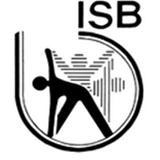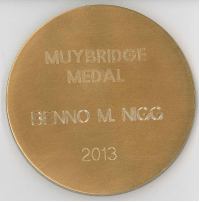International Society of Biomechanics
The International Society of Biomechanics, commonly known as the ISB, is a society dedicated to promoting biomechanics in its various forms. It promotes the study of all areas of biomechanics at the international level, although special emphasis is given to the biomechanics of human movement. The Society encourages international contacts amongst scientists, promotes the dissemination of knowledge, and forms liaisons with national organizations. The Society's membership includes scientists from a variety of disciplines including anatomy, physiology, engineering (mechanical, industrial aerospace, etc.), orthopedics, rehabilitation medicine, sport science and medicine, ergonomics, electro-physiological kinesiology and others.
 | |
| Formation | August 29th, 1973 |
|---|---|
| Website | http://www.isbweb.org/ |
History
The decision to establish the society was made at the 3rd International Seminar on Biomechanics held in Rome in 1971. This meeting was organized by the “Working Group on Biomechanics” which was part of the International Council of Sport and Physical Education, which itself was part of the United Nations Educational, Scientific, and Cultural Organization (UNESCO). At this meeting on September 29 it was voted to form the ISB at the next meeting. The 4th International Seminar on Biomechanics was held at Penn State University from August 26 until August 31, 1973. The constitution was voted on and approved on August 29.[1] Two hundred and fifty of those present became charter members of the society.
Executive Council
The ISB is governed by its Executive Council. This council is elected every two years, by ballot, and is composed of officers and council members that represent countries from throughout the world and scientific areas that span all facets of biomechanics. The council, which meets annually, provides leadership for the continued development of the Society. Many on-going activities are performed by Council appointed sub-committees. The council also publishes a quarterly newsletter, known as ISB NOW, to inform members of Society developments and future events.[2]
Congresses
The ISB was formed in 1973 and has held a conference every other year since then. The counting of the congress started with the 1st International Seminar on Biomechanics held in Zurich in 1967. The list of conferences and their geographical locations are given below.[3]
| Conference Number | Year | Location |
|---|---|---|
| I | 1967 | Zurich, Switzerland |
| II | 1969 | Eindhoven, Netherlands |
| III | 1971 | Rome, Italy |
| IV | 1973 | State College, USA |
| V | 1975 | Jyvaskyla, Finland |
| VI | 1977 | Copenhagen, Denmark |
| VII | 1979 | Warsaw, Poland |
| VIII | 1981 | Nagoya, Japan |
| IX | 1983 | Waterloo, Canada |
| X | 1985 | Umea, Sweden |
| XI | 1987 | Amsterdam, Netherlands |
| XII | 1989 | Los Angeles, USA |
| XIII | 1991 | Perth, Australia |
| XIV | 1993 | Paris, France |
| XV | 1995 | Jyvaskyla, Finland |
| XVI | 1997 | Tokyo, Japan |
| XVII | 1999 | Calgary, Canada |
| XVIII | 2001 | Zurich, Switzerland |
| XIX | 2003 | Dunedin, New Zealand |
| XX | 2005 | Cleveland, USA |
| XXI | 2007 | Taipei, Taiwan |
| XXII | 2009 | Cape Town, South Africa |
| XXIII | 2011 | Brussels, Belgium |
| XXIV | 2013 | Natal, Brazil |
| XXV | 2015 | Glasgow, Scotland |
Wartenweiler Memorial Lecture
At each ISB Congress the Wartenweiler Memorial Lecture is presented. This lecture is named to honor Jurg Wartenweiler (1915-1976) who was the first president of the ISB. He organized The First International Seminar on Biomechanics in Zürich, Switzerland in 1967. This conference eventually morphed into the biennial ISB Congresses. He was a faculty member at the ETH Zürich. Typically this lecture has been the first academic presentation of the conference. The list of Wartenweiler Memorial Lecturers and their topics follow.[4]
| Year | Speaker | Topic |
|---|---|---|
| 1977 | Giovanni A. Cavagna | Efficiency and inefficiency of locomotion. |
| 1979 | Marion Weiss | Tasks and needs of rehabilitation engineering. |
| 1981 | Phillip D. Gollnick | Muscle characteristics and biomechanics. |
| 1983 | Uros Stanic | Movement and electrical stimulation. |
| 1985 | Don B. Chaffin | Computerized models for occupational biomechanics. |
| 1987 | Savio Woo | Advances in ligament research. |
| 1989 | Benno Nigg | Approaches to load analysis for reduction of sports injuries. |
| 1991 | James G. Hay | Biomechanics of long jumping. |
| 1993 | Carlo A. De Luca | Limitations of EMG in biomechanics research. |
| 1995 | David A. Winter | Biokinetics: The synergies of human movement. |
| 1997 | V. Reggie Edgerton | Force transmissions in mammalian skeletal muscles. |
| 1999 | Andrew Huxley | Crossbridge action: Present views, prospects & unknowns. |
| 2001 | Richard C. Nelson | The history of ISB. |
| 2003 | Steven Vogel | Twist versus bend: Flexibility in the face of flow. |
| 2005 | Bruce Latimer | Biomechanics and evolution. |
| 2007 | Kai-Nan An | Application of medical imaging in biomechanics. |
| 2009 | Patrick Prendergas | Mechanoregulation in the skeletal tissues. |
| 2011 | Jan Pieter Clarys | The schizophrenic balance of old techniques and new technologies in body composition and their (assumed) support in biomechanics, ergonomics and health care. |
| 2013 | Miguel Nicolelis | Brain machine interfaces to restore mobility. |
Muybridge Medal

At the ISB Congress every two years, the ISB presents the Muybridge Award. This award is the most prestigious award of the Society and is awarded for career achievements in biomechanics. The award is named after Eadward Muybridge (1830-1904), who was one of the first to use cinematography for the study of human and animal movement. The list of Muybridge Award winners and their lecture topics follow,[5]
| Year | Speaker | Topic |
|---|---|---|
| 1987 | Peter R. Cavanagh | Studies in the biomechanics of distance running and plantar pressure distribution. |
| 1989 | Gunnar Andersson | Spine biomechanics. |
| 1991 | R. McNeil Alexander | Optimization of structure and movement of the legs of animals. |
| 1993 | Malcolm H. Pope | Spinal biomechanics. |
| 1995 | Savio L-Y. Woo | Biomechanics of knee ligament healing, repair and reconstruction. |
| 1997 | John Paul | Strength requirements for internal and external prostheses. |
| 1999 | Paavo Komi | Stretch-shortening cycle: a powerful model to study normal and fatigued muscle. |
| 2001 | David Winter | Gait and balance - from the micro to the macro. |
| 2003 | Tetsuo Fukunaga | Effects of elastic properties of muscle-tendon complex on sports performances. |
| 2005 | Rik Huiskies | Bone: The engineer's ultimate dream material |
| 2007 | Peter Huijing | Epimuscular myofascial force transmission: a historical review and implications for new research. |
| 2009 | Mimi Koehl | Effects of ambient wind or water flow on locomotion. |
| 2011 | Roger Enoka | Muscle fatigue – from motor units to clinical symptoms |
| 2013 | Benno Nigg | From biomechanik to biomechanics to biomechanigg |
Honorary Member
The ISB has a number of categories of membership including: student, charter, full, and emeritus. The remaining category is that of honorary member, which is restricted to a few individuals whose work has made outstanding contributions to the development of Biomechanics. The honorary membership currently consists of 16 individuals. Unfortunately some of these members have died (Levan Chkhaidze, James Hay, Ernst Jokl, Chauncey Morehouse, John Paul, Jacquelin Perry, David Winter). The other honorary members and their current academic affiliations are,[6]
- Peter R. Cavanagh, University of Washington, USA
- Paavo Komi, University of Jyvaskyla, Finland
- Hideji Matsui, University of Nagoya, Japan
- Doris Miller, University of Western Ontario, Canada
- Mitsumasa Miyashita, University of Tokyo, Japan
- Richard C. Nelson, Penn State University, USA
- Benno Nigg, University of Calgary, Canada
- Robert Norman, University of Waterloo, Canada
- Fred Yeadon, Loughborough University, UK
Affiliated Groups
Many other biomechanics groups and societies are affiliate members of the ISB. These groups include:[7]
- American Society of Biomechanics
- Australia/New Zealand Society of Biomechanics
- Brazilian Society of Biomechanics
- British Association of Sport and Exercise Sciences
- Bulgarian Society of Biomechanics
- Canadian Society of Biomechanics
- Chinese Society of Sports Biomechanics
- Czech Society of Biomechanics
- Danish Society of Biomechanics
- German Society of Biomechanics
- Hellenic Society of Biomechanics (Greece)
- International Society of Biomechanics in Sports
- Japanese Society of Biomechanics
- Korean Society for Orthopaedic Research, Biomechanics, and Basic Science
- Polish Society of Biomechanics
- Portuguese Society of Biomechanics
- Russian Society of Biomechanics
- Societe de Biomecanique (France)
- Taiwanese Society of Biomechanics
Technical and Working Groups
The Society also supports technical and working groups, which are groups of individuals dedicated to enhancing knowledge of specialized areas within biomechanics. Currently active technical sections include,[8]
References
- "ISB Constitution and Codes". International Society of Biomechanics. Retrieved 2014-05-20.
- "Executive Council and Officers". International Society of Biomechanics. International Society of Biomechanics. Retrieved 24 June 2014.
- "ISB Congresses". International Society of Biomechanics. International Society of Biomechanics. Archived from the original on 2 March 2014. Retrieved 24 June 2014.
- "Wartenweiler Memorial Lecture". International Society of Biomechanics. Archived from the original on 2014-07-11. Retrieved 2014-05-20.
- "Muybridge Award". International Society of Biomechanics. International Society of Biomechanics. Archived from the original on 13 July 2014. Retrieved 24 June 2014.
- "Honorary Members". International Society of Biomechanics. International Society of Biomechanics. Archived from the original on 13 July 2014. Retrieved 24 June 2014.
- "Affiliate Societies". International Society of Biomechanics. International Society of Biomechanics. Archived from the original on 17 March 2014. Retrieved 24 June 2014.
- "ISB Technical and Working Groups". International Society of Biomechanics. International Society of Biomechanics. Archived from the original on 17 March 2014. Retrieved 24 June 2014.